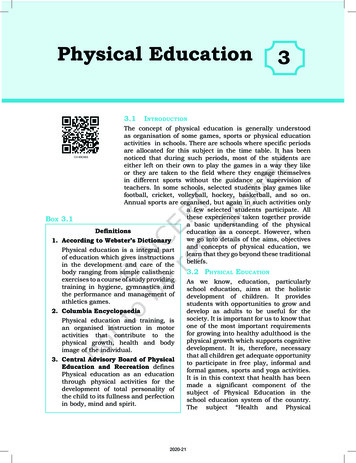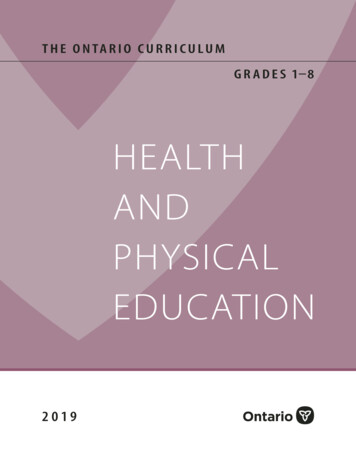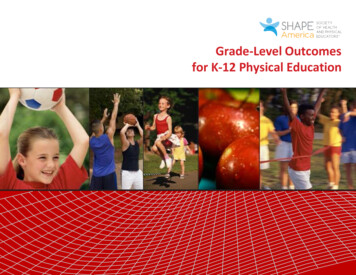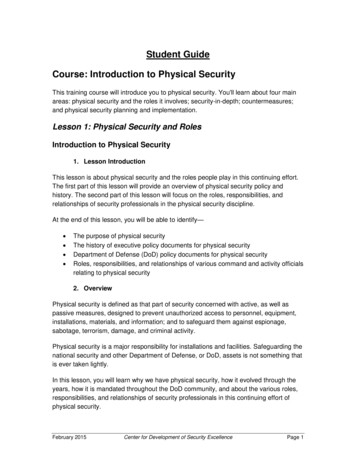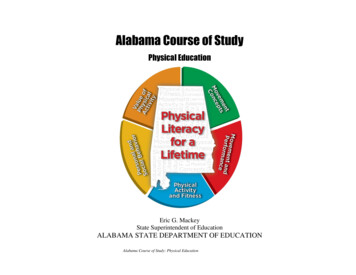
Transcription
Alabama Course of StudyPhysical EducationEric G. MackeyState Superintendent of EducationALABAMA STATE DEPARTMENT OF EDUCATIONAlabama Course of Study: Physical Educationi
\For information regarding theAlabama Course of Study: Physical Educationcontact the Instructional Services Division,Alabama State Department of Education,3345 Gordon Persons Building,50 North Ripley Street, Montgomery, Alabama 36104;or by mail to P.O. Box 302101, Montgomery, Alabama 36130-2101;or by telephone at (334) 694-4768.Eric G. Mackey, State Superintendent of EducationAlabama State Department of EducationThe Alabama State Board of Education and the Alabama State Department of Education do not discriminate based on race, color, national origin, sex, disability, or age intheir programs and activities and provide equal access to the Boy Scouts and other designated youth groups. The following person has been designated to handle inquiriesregarding the non-discrimination policies:Title IX CoordinatorAlabama State Dept. of EducationP. O. Box 302101Montgomery, AL 36130(334) 694-4723Alabama Course of Study: Physical Educationi
STATE SUPERINTENDENTOF EDUCATION’S MESSAGEMembersof theAlabama State Boardof EducationDear Educator:Quality physical education is an essential component of the educational preparation for Alabamastudents with planned, sequential, standards-based curriculum and instruction. It is designed todevelop motor skills, knowledge, and behaviors for active living, physical fitness, sportsmanship,self-efficacy, and emotional intelligence. A quality physical education program is an essentialpart of the Whole School, Whole Child, Whole Community (WSCC) and the Every StudentSucceeds Act (ESSA), which promotes a well-rounded education for every child. Strongevidence demonstrates that the physical fitness and motor skill development of children and youthare substantially enhanced by a quality physical education program. Active Living Researchconcludes more time in physical education leads to improved grades and standardized test scores.In schools that are under government mandates to bridge the achievement gap, physical educationcan actually help improve the students’ scores.The learning environment in physical education has changed dramatically since the start of the21st century. Previously a sports- and recreation-based class, physical education has transformedinto a content area focused on behavioral changes and lifelong healthful living. (Committee onPhysical Activity and Physical Education in the School Environment; Food and NutritionBoard; Institute of Medicine, 2013, Ennis, 2014).The 2019 Alabama Course of Study: Physical Education serves as the foundation for thedevelopment of physical education programs that can improve and enhance the quality of life forAlabama students. By participating in developmentally appropriate practices outlined in thiscourse of study, students learn health-enhancing and appropriate interactive behaviors whileexperiencing positive outcomes in motor skill development. This document provides the baseupon which local school systems design programs to ensure quality physical educationexperiences for all Alabama students.The Centers for Disease Control and Prevention (CDC) states that regular physical activity has apositive impact on cognitive skills, attitudes, and academics, which are important for improvingacademic outcomes. Physical activity enhances concentration and attention and improvesclassroom behavior.With a strong foundation provided by this course of study, we continue to build a relationshipbetween physical education, arts, literacy and other content areas to ensure every child has a wellrounded education. Our ultimate goal is to create life-long healthy learners.Eric G. MackeyState Superintendent of EducationAlabama Course of Study: Physical EducationGovernor KAY IVEYPresident of the State Board of EducationDistrictIIIJackie ZeiglerTracie WestIIIStephanie W. BellIVYvette Richardson, EdDVVIElla B. BellCynthia Sanders McCarty, PhDVice PresidentVIIJeffery NewmanPresident Pro TemVIIIWayne Reynolds, EdDState SuperintendentEric G. MackeySecretary and Executive Officerii
Alabama Course of Study: Physical EducationTable of ContentsPreface . vAcknowledgements . 1General Introduction . 4Synopsis of Laws, Regulations, and Resolutions Relating to Physical Education . 6Conceptual Framework Graphic . 9Position Statements . 10Anchor Standards for K-12 Physical Education. 18Grades K-5 Overview . 19Grades K-5 Standards . 21Grades 6-8 Overview . 34Grades 6-8 Standards .36Grades 9-12 Overview . 47Beginning Kinesiology .49High School Physical Education Elective Courses . 56Appendix A: Curriculum Development/Design .73Appendix B: Designing and Planning Scope and Sequence 74Appendix C: Indicators of Effective Physical Education Instruction .75Appendix D: Instructionally Appropriate Activities 77Appendix E: Assessment Sample Grading Rubric . 78Appendix F: Rate of Perceived Exertion .79Appendix G: Kinesiology Courses Pacing Guide 80Appendix H: Weekly Lesson Plan Template .81Alabama Course of Study: Physical Educationiii
Appendix I: Activity Categories with Examples .83Appendix J: Major Muscle Groups .84Appendix K: Skill Related Fitness .85Appendix L: FITT Principle 86Appendix M: Middle School Physical Education 87Appendix N: Preschool Physical Education Standards 97Appendix O; Alabama High School Graduation Requirements .98Appendix P: Literacy Standards .99Bibliography. 109Glossary . 111Alabama Course of Study: Physical Educationiv
PrefaceThe 2018-2019 Physical Education Course of Study Subcommittee extensively used the National Standards and Grade-Level Outcomes for PhysicalEducation, published by Society of Health and Physical Educators (SHAPE) America in 2013. In addition, subcommittee members attended state,regional, and national conferences; read professional journals and researched best practices; reviewed similar courses of study from other states; listenedand responded to public comments and to outside reviewers from Alabama’s postsecondary institutions; used each member’s academic and experientialknowledge; and discussed issues among themselves and with colleagues. Finally, the subcommittee reached consensus and developed what it believes tobe the best possible physical education course of study for Alabama’s K-12 students.Alabama Course of Study: Physical Educationv
AcknowledgementsAlabama Course of Study: Physical EducationThis document was developed by the 2018-2019 Alabama Physical Education Course of Study Subcommittee of the Health and Physical EducationCommittee and Task Force, composed of early childhood, intermediate school, middle school, high school, and college educators appointed by theAlabama State Board of Education and business and professional persons appointed by the Governor (Code of Alabama, 1975, §16-35-1). The Committeeand Task Force began work in March of 2018 and submitted the document to the Alabama State Board of Education for adoption at the March 2019meeting.Chairperson, Health and Physical Education Committee and Task ForceKathy L. Murphy, EdD, Superintendent, Hoover City Board of Education2018-2019 Alabama Physical Education Course of Study Subcommittee MembersGinger M. Aaron-Brush, Physical Education Specialist, Pelham Oaks Elementary School, Pelham City Schools (National Board CertifiedPhysical Education)William Darran Alexander, Assistant Principal, SPARK Academy at Cowart Elementary School, Athens City SchoolsCharlotte Beasley, Physical Education Specialist, Winfield Elementary School, Winfield City SchoolsJill Burt, Adapted Physical Education Specialist, Lead Physical Education Specialist, Selma City SchoolsCherie Cain, School Liaison Officer, Child & Youth Services Director of Family and Morale, Welfare and Recreation, Redstone ArsenalKenneth E. Carter, Adapted Physical Education Specialist, Montgomery County SchoolsBertram L. Crum, Physical Education Specialist, William R. Martin Middle School, Dallas County SchoolsPenny Edwards, Senior Program Manager, Alliance for a Healthier GenerationRosalyn Fabianke, Governor’s Commission on Physical Fitness and SportsAllison Jackson, PhD, Assistant Professor, Samford UniversityAmanda Hayes, Physical Education Specialist, Hewitt-Trussville Middle School, Trussville City SchoolsAlabama Course of Study: Physical Education1
George Hennicke, Physical Education Specialist, Winfield Elementary School, Winfield City SchoolsSherri L. Huff, PhD, Program Specialist, K-12 Physical Education, Birmingham City SchoolsSheila L. Jett, Physical Education Specialist, Montevallo Middle School, Shelby County Schools (National Board Certified PhysicalEducation)Cheryl Johnston, Adapted Physical Education Specialist, Mobile County Public School SystemDerrick Louis Lane, Physical Education Specialist, Morris Slingluff Elementary School, Dothan City SchoolsPatty Laughlin, Adapted Physical Education Specialist, Decatur City SchoolsJanet Long, Adapted Physical Education Specialist, Montgomery County SchoolsRhonda L. Mann, Deputy Director, VOICES for Alabama’s ChildrenDebra A. McDonald, Physical Education Specialist, Richland Elementary School, Auburn City SchoolsCindy O’Brien, Physical Education Specialist, Hueytown Elementary School, Jefferson County School SystemMaurice G. Woody, Principal, Monroe County High School, Monroe County School SystemBeth Uhlman, Physical Education Specialist, Pizitz Middle School, Vestavia City SchoolsThe 2018-2019 Health Education Course of Study Subcommittee reviewed the document. Its members were:David Bell, Tracy Box; Angela Carter; Jacqueline Chambers Eckell; Connie O. Dacus; Flavia Payson Freeney; Joe L. Goble, Jessica James;Nekeysha D. Jones; Donald Little; Samuel Allen Maness; Nan M. Priest, Beth K. Prine; Sarah E. Toth, PhD; and Joi M. Washington.Appreciation is extended to Peter Hastie, PhD, Auburn University; Donna Hester, PhD, ASAHPERD Executive Director; Sandra Sims, PhD, TheUniversity of Alabama Birmingham; and Michael Gross, PhD, Auburn University Montgomery, who served as content reviewers of this document.Consultant to the Subcommittee during the development of the document was:Laurie Eldridge-Auffant, Disability and Health Program Director, Nutrition & Physical Activity Division, Alabama Department ofPublic HealthAlabama Course of Study: Physical Education2
Alabama State Department of Education personnel who managed the development process were:Eric G. Mackey, EdD, State Superintendent of EducationDaniel Boyd, EdD, Deputy State SuperintendentJeffery E. Langham, EdD, Assistant State SuperintendentElisabeth Davis, EdD, Assistant State Superintendent, Office of Student LearningRobin A. Nelson, Program Coordinator, Instructional ServicesMichelle Matin, Executive Secretary, State Courses of Study Committees, Instructional Services Section.Alabama Department of Education content specialist who assisted the Subcommittee in developing the document was:Nancy M. Ray, Health and Physical Education Specialist, Instructional Services.Alabama Department of Education process specialist who assisted the Subcommittee in developing the document was:Denise Wilson, Preschool Specialist, Special Education ServicesCharles V. Creel, Graphic Arts Specialist, Communication Section, assisted in the development of the graphic design.Catherine W. Wilbourne, Gifted Education Teacher (retired), Eufaula City Schools, edited and proofread the document.Alabama Course of Study: Physical Education3
Alabama Course of Study: Physical Education General IntroductionThe 2019 Alabama Course of Study: Physical Education provides the framework for the physical education program for Grades K-12 in Alabama’s publicschools. The document outlines content standards for physical education in Grades K-8; the required high school course, Beginning Kinesiology; and highschool elective courses. These standards emphasize a continuum of learning, building on elements taught in each grade. For this reason, standards for GradesK-5 and 6-8 have been formatted to make the document more user-friendly, allowing teachers to see progression across the grade levels. Alabama’s physicaleducation program focuses on both student participation and student learning to achieve mastery of the content standards within this document.The overall goal of Alabama’s K-12 physical education program is to produce physically literate individuals through standards-based best practices. Aphysically literate individual is defined as a person who has the ability to move with competence and confidence in a wide variety of physical activities inmultiple environments that benefit the healthy development of the whole person. The standards provide a vision of what it means to be a physically literateperson at each grade level.The 2019 Alabama Course of Study: Physical Education is based upon current knowledge and research regarding developmentally appropriate practices,outcomes, and objectives. It identifies the minimum content that students must know by the end of each grade level or course and provides guidance foreducators in designing quality physical education programs characterized by strong curriculum and positive learning opportunities. By participating inquality physical education programs, students become physically literate and active for life.The Society for Health and Physical Educators (SHAPE) America has established broad national standards which provide the framework for comprehensive,high-quality physical education programs and identify what students should know and be able to do as a result of their participation. SHAPE Americastandards were carefully considered in developing these Alabama standards.National statistics clearly indicate that the prevalence of overweight and obese children has reached alarming levels. Research shows that students whoparticipate in regular, fitness-based physical education show improved health, enhanced academic achievement, increased on-task behavior, betterconcentration, decreased absenteeism, healthier school culture, and increased problem-solving skills.1 Every Student Succeeds Act (ESSA) emphasizes theimportance of physical education in the well-rounded education of all students. Physical education encourages a positive attitude toward self and others, animportant factor in creating a safe and healthy learning environment, which fits perfectly with Alabama’s vision for education.Alabama schools have a responsibility to provide quality physical education programs that allow Grades K-12 students to acquire the knowledge and skillsnecessary to maintain healthy lifestyles that contribute to a better quality of life. Positive habits established during childhood and adolescence are vital to thehealth and wellness of adults and, therefore, must be addressed within the school curriculum. The skills and knowledge students are expected to demonstratealso have wide applicability outside the school ical-Activity-and-ObesityAlabama Course of Study: Physical Education4
The “HOW” IS NOT INCLUDED IN THE STANDARDSThe standards in the 2019 Alabama Course of Study: Physical Education define what all students are expected to know and be able to do, not howteachers should teach. Standards focus on what is essential; they do not attempt to describe all that can or should be taught. A great deal is left to thediscretion of teachers and curriculum developers. The standards must be implemented by a well-developed, skills- and content-rich curriculum and aprogram consistent with the expectations laid out in this document. School-based sports programs are not a substitute for a quality physical educationprogram.The standards set specific expectations for each grade, but do not fully reflect the great variety of abilities, needs, learning rates, and achievement levelsof students in any given classroom. Therefore, the standards do not define the intervention methods or materials necessary to support students who arebelow or above grade-level expectations. While all students must have the opportunity to access the knowledge and develop the skills necessary forlifelong physical literacy, it is beyond the scope of the 2019 Alabama Course of Study: Physical Education to define the full range of supportsappropriate for the physical education of students with special needs.Cardiopulmonary Resuscitation (CPR), Automatic External Defibrillator (AED) use, and first aid are covered in the standards for health education andare therefore not included in standards for physical education.Although it is not specifically articulated in the standards, the mind-body connection, which contributes greatly to a well-rounded education, is a coreconcept in everything taught in physical education. Growing research continues to show that increased academic success correlates with increasedphysical activity. Mind-body connection is a concept that should be integrated into every aspect of a quality physical education program.Alabama Course of Study: Physical Education5
Synopsis of Laws, Regulations, and Resolutions Relating to Physical EducationReference InformationThe Code of Alabama contains lawspassed by the state legislature. Areference to the Code of Alabama hasthree parts: Title, Chapter, andParagraph. Laws related to educationare located in (Title) §16. Chapters arenumbered and organized by topic.Paragraphs may be located within thereferenced Chapter.The Alabama Administrative Code(AAC) contains policies and regulationsadopted by the Alabama State Board ofEducation. For example, the AlabamaHigh School Graduation Requirements(AAC r. 290-3-1-.02(8)(a-b)) are foundon pages 66-67.The Alabama Course of Study: PhysicalEducation contains minimum requiredcontent standards and implementationguidelines for physical education.Alabama State Board of Educationresolutions or directives from theAlabama State Superintendent ofEducation provide additional guidancefor physical education.In addition to implementing the minimum course content outlined in the Alabama Course of Study:Physical Education, local school systems must abide by certain laws and Alabama State Board ofEducation resolutions that govern other aspects of the physical education program. Listed below are someof the laws, regulations, and resolutions that have relevance for physical education programs in Alabamaschools.Physical Education RequiredEvery public school and private school, except church schools as defined in the Code of Alabama, 1975,§16-28-1, shall carry out a system of physical education, the character of which shall conform to theprogram or course outlined by the Alabama Department of Education (Code of Alabama, 1975, §16-401). Therefore, according to law, the minimum required content found in the Alabama Course of Study:Physical Education must be taught in all public schools in Alabama.Precedent-Setting Court CaseMitchell v. McCallThe program of education prescribed under this delegated authority is legislative in nature and has thecoercive effect of law (Mitchell v. McCall, 273 Ala. 604, 143 So. 2d 629, 1962); (Code of Alabama, 1975,§16-40-1).Grades K-8 RequirementDaily physical education instruction is required for a minimum of 30 minutes for Grades K-5 and aminimum of 50 minutes for Grades 6-8 with no exceptions or substitutions and may not be combined withlunch time. Recess time may not be substituted for physical education and should not take placeimmediately before or after physical education class time. (Code of Alabama 1975, §16-40-1).Physical Education Certification RequirementsDaily physical education classes for all students in Grades K-8 must be taught or supervised by teacherscertified in physical education (Alabama State Board of Education Resolution F-17, February 1984).Alabama Course of Study: Physical Education6
Synopsis of Laws, Regulations, and Resolutions, [continued]All elementary physical education classes must be taught by:1. A certified physical education teacher employed to teach physical education; or2. A paraprofessional employed to provide additional instruction in physical education classes on the same campus under the direct supervisionof a certified physical education specialist, who must follow the lesson plans provided by the physical education specialist; or3. A classroom teacher certified to teach physical education only to their homeroom students.Notes: All physical education teachers who hold Alabama Grades P-12 Certification in Physical Education are required by law to provideinstruction to all students (Alabama Administrative Code, Chapter 290-3-3-.33).Certification or endorsement in adapted physical education is not required in Alabama.No Exception to Required One-Credit Physical Education Course in Grades 9-12Until funding is obtained for K-8 physical education teachers at every school within a school system, there will be no exception to the requiredone-credit course in Grades 9-12 (Alabama State Board of Education Resolution H-1, April 1985).Sex Discrimination LawNo person in the United States shall, on the basis of sex, be excluded from participation in, be denied the benefits of, or be subjected todiscrimination under any education program or activity receiving federal financial assistance (Public Law 92-318, Title IX).Individuals with Disabilities Education ActEach child with disabilities must be afforded the opportunity to participate in the regular physical education program available tonondisabled children unless the child is enrolled full time in a separate facility or the child needs specially designed physical educationinstruction, as prescribed in the child’s individualized education program (Public Law 91-230, as amended). Every student with a disabilityshall receive appropriate daily physical education in his or her least restrictive environment through one of the following options:1.2.3.4.Students may be included with regular physical education classes of like age or ability;A teacher of adapted physical education may be employed to provide instruction;Special education teachers may provide instruction in physical education for their own students; orAn outside agency may be contracted to provide instruction or therapy for severely handicapped students.Accountability LawNothing in the Core Curriculum Act shall be construed to diminish the current requirements of the Alabama State Board of Education withrespect to health and physical education instruction in Grades K-12 or to reduce the effect of Code of Alabama, 1975, §16-40-1, regarding Healthand Physical Education (Code of Alabama, 1975, §16-6B-2(d)).Alabama Course of Study: Physical Education7
Alabama Course of Study: Physical EducationConceptual FrameworkThe conceptual framework highlights the important features of the 2019 Alabama Course of Study: Physical Education. Physical Literacy for a Lifetimeis the overall goal of Alabama’s physical education program, from kindergarten through high school. The phrase is placed prominently at the center of thestate map, highlighting the aim of physical education – to have a positive, lasting impact on the lives of all Alabama students. The background of the stateis filled with positive terms which highlight the importance of activity in achieving a healthy lifestyle. The goal is surrounded by five anchor standardswhich form the foundation for physical literacy. These interconnected standards are addressed at every grade level to achieve a balanced approach tobecoming a physically literate individual.Movement and performance standards guide students to demonstrate competency and skill in both movement and motor patterns through a variety ofmovement experiences.Movement concepts standards are closely linked to performance, providing the conceptual understanding needed to utilize skills appropriately. Thesestandards lead students to be successful when applying various strategies and tactics in a wide range of settings.Physical activity and fitness standards focus on attaining the knowledge, skills, and confidence to achieve and maintain health-enhancing physical fitness,including cardio-respiratory endurance, muscular strength, muscular endurance, flexibility, and body composition. The standards provide students theopportunity to identify and reach appropriate levels of physical fitness for an active lifestyle throughout their lives.Personal and social behavior highlights the importance of developing behaviors that demonstrate respect for self and others. These standards focus oncreating opportunities for students to exhibit personally and socially responsible attitudes and behaviors when interacting with others, participating incompetitive activities, handling conflict, and showing appropriate sporting behavior both as participants, assistants enabling others, and as spectators.These skills learned in physical education class will be valuable in personal and social situations for the rest of students’ lives.Value of physical activity recognizes the importance of the many benefits of physical activity on the overall quality of life. Physical activity has a positiveimpact on health, provides enjoyment, provides self-challenging opportunities, develops self-confidence, allows for self-expression, and encourages socialinteraction. Students learn to value activity for its effect on their own lives and are guided to develop a mindset that motivates them to be physically literatefor a lifetime.Alabama Course of Study: Physical Education8
Conceptual Framework GraphicAlabama Course of Study: Physical Education9
Position StatementsQuality Physical Education ProgramA quality physical education program follows an appropriate, sequential curriculum that delivers learning experiences to all students. A qualityphysical education curriculum is the framework that provides guidance for teaching methods, provides physical activity instruction, and is based onthe Alabama Course of Study: Physical Education, which describes what a physically educated student should know and be able to do. Theeffectiveness of school physical education is enhanced when it is implemented as an integral part of the academic climate of the school.Physical LiteracyPhysical literacy is “the ability to move with competence and confidence in a wide variety of physical activities in multiple environments that benefitthe healthy development of the whole person.” According to Mandigo, Francis, Lodewyk and Lopez, a physically literate i
Previously a sports- and recreation-based class, physical education has transformed into a content area focused on behavioral changes and lifelong healthful living. (Committee on Physical Activity and Physical Education in the School Environment; Food and Nutrition
